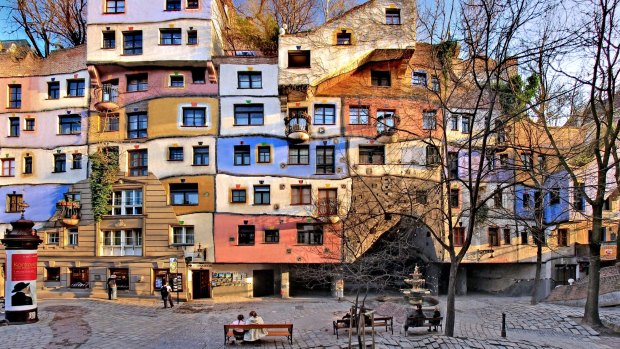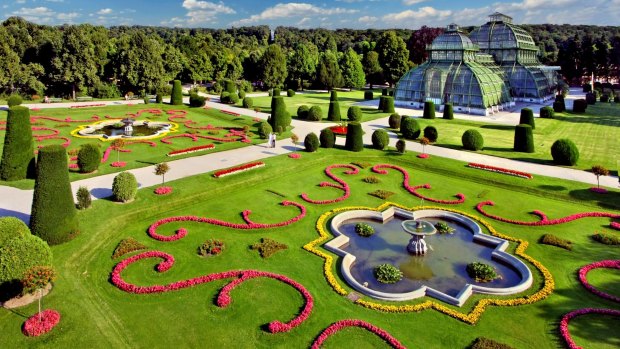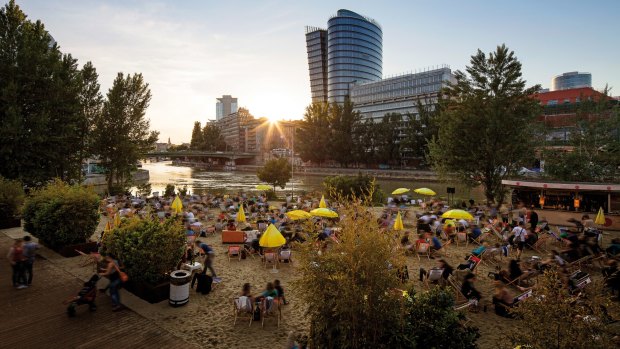By Daniel Scott

The central Hundredtwasserhaus apartment block with its colourful higgledy-piggledy façade revealing the influence Barcelona's Antoni Gaudi.
It takes a special combination of ingredients, including political stability, low crime rates, good housing and recreational facilities, for a sprawling metropolis to be named the "world's most liveable city", beating 229 other nominees, including Sydney (10th) and Melbourne (15th), for the seventh time running this year.
The city won the accolade in the Mercer Quality of Living Rankings a http://www.traveller.com.au/worlds-most-liveable-cities-2016-vienna-sydney-and-melbourne-rank-in-top-20-gn1vug
However, on this morning's long bike ride around Vienna, I'm convinced that it's the landlocked city's kilometres of greenery and waterways and the use generations of urban planners have made of them that contributed most to it winning the accolade.

The Palmenhaus Schönbrunn is a large greenhouse in Vienna, featuring plants from around the world. It was opened in 1882.
"More than 50 per cent of Vienna is made up of green spaces," says Alexa Braüner, my guide, as we cycle along the traffic-free, central boulevard in the Prater, six square kilometres of gardens at the edge of the Danube River.
"The Prater is a very important place for Vienna," adds Braüner, as stylish and fit in her late forties as I am daggy and sweaty, puffing along beside her, "it's like the city's lungs, breathing fresh air into its downtown area."
Once part of the Danube flood plain and later annexed as a hunting park by the Habsburg emperors, it's now a domain for Vienna's fortunate citizens, some of whom are bowling along beside us on inline skates, or on horseback, as well as jogging, strolling and pushing prams. This main thoroughfare, Prater Hauptalee, is a four-kilometre long avenue, lined by rows of horse chestnut trees, 2500 in all.

The beach bar on the Danube canal.
The Prater is one of more than 850 parks in Vienna, and those horse chestnuts comprise a fraction of its 100,000 trees. These figures, Vienna's 1200 kilometres of bike lanes, with city bikes, available free for the first hour, from 120 venues, suggest an ongoing urban vision, stretching back centuries.
Another example of this prescience is that on this 60-kilometre ride, beginning in the city's historic heart and remaining close to different branches of the Danube, including its central canal, we are rarely far from one of Vienna's 900 drinking water fountains.
Since 1873, Vienna's drinking water has been piped into the city from 30 springs in nearby mountains.
Two years later, Viennese authorities anticipated the threat of flooding from the Danube, Europe's second-longest river, by regulating its course away from the city centre. Yet it wasn't until a hundred years later that, with the construction of a further relief channel, creating a parallel section of the river along its city course, the Danube became pivotal to city's recreation.
For, sandwiched between the "new" and the original Danube, there was now a 21-kilometre artificial island, between 70-120 metres wide and lined by an urban beach, which the Viennese took to with alacrity. Only six minutes via the underground from St Stephen's cathedral, the island soon became popular for sunbathing, swimming and hanging out on weekends and summer evenings in riverfront bars.
Reaching the island shortly after riding through the Prater, guide Braüner and I find it busy with fellow cyclists and with runners and the new Danube full of sailing boats and windsurfers, taking advantage of the breeze blowing off the Viennese hills. There is even a 250-metre section of white water, along which several kayakers are slaloming. Further on, on the shores of the "Alte" or Old Danube, an arcing former branch of the river, the pace is slower, with people chuffing along in pedalos and rowboats on the water and stretched out on wooden decking on the shore.
"It's not bad for a summer workday, is it?" asks Braüner, rhetorically.
The Viennese needn't go that far to swim and sunbath, as I discover near the beginning of our ride, on the banks of the Danube canal.
Arrayed along its shores are bars and beach clubs and moored on the canal is the Badeschiff outdoor swimming pool and sundeck, glinting on top of a cargo boat.
Beginning our ride along the Ringstrasse boulevard in the city centre, I can see that Vienna is green to the core, with parks like the Volksgarten (with 400 varieties of rose), the English landscape gardens of the Rathauspark and the Burggarten, beside the grandiloquent Hofburg imperial palace, laid out in 1818.
Formal baroque grounds also distinguish both the Schönbrunn palace and the glorious Belvedere complex, with its French style gardens created in 1700. The adjacent Botanical gardens, cultivated by the Empress Maria Theresa, in 1754, now feature 11,000 species from six continents.
While the all-powerful Habsburg dynasty clearly had a healthy vision of the city's future, the Vienna-born artist and architect nicknamed "Hundredtwasser" (1928-2000) was further ahead of his time, championing nature and social housing in his designs.
Early in the day we stop by the central Hundredtwasserhaus apartment block, its roof covered in grass, its rooms built around the trunks and limbs of trees, its colourful higgledy-piggledy façade revealing the influence Barcelona's Antoni Gaudi, and its corridors deliberately undulating.
"An uneven floor is a melody to the feet," explained Hundredtwasser, who refused payment for the building's design, happy that his work could "prevent something ugly going up in its place". It now houses 51 families and has a children's playground on the ground floor.
From its core to the city limits, where the green belt includes the Vienna woods to the west, with its own biosphere, and the Donau Auen National park, incorporating the 2300-hectare Lobau wetlands, in the east, the Austrian capital abounds with natural assets.
Taking in some of these on this morning ride, it's clear that Vienna has become the world's most livable city, not by accident but by design, and that a long held-recognition of the benefits of greenery and recreational facilities is crucial to its success.
TRIP NOTES
MORE INFORMATION
GETTING THERE
Qantas and partners fly from Sydney/Melbourne to Vienna from $1800 return. Qantas.com.au
STAYING THERE
25hours Hotel, Lerchenfelder Strasse 1-3, 1070 Vienna, is a circus-themed central hotel with rooms from €102 ($150)
25hours-hotels.com/en/museumsquartier/home/home.html
TOURING THERE
Pedal power rents bikes and offers tours. Pedalpower.at
Guided cycle tours are available at Alexabrauner.at/en
Daniel Scott travelled courtesy of the Austrian National Tourist Office
Sign up for the Traveller Deals newsletter
Get exclusive travel deals delivered straight to your inbox. Sign up now.